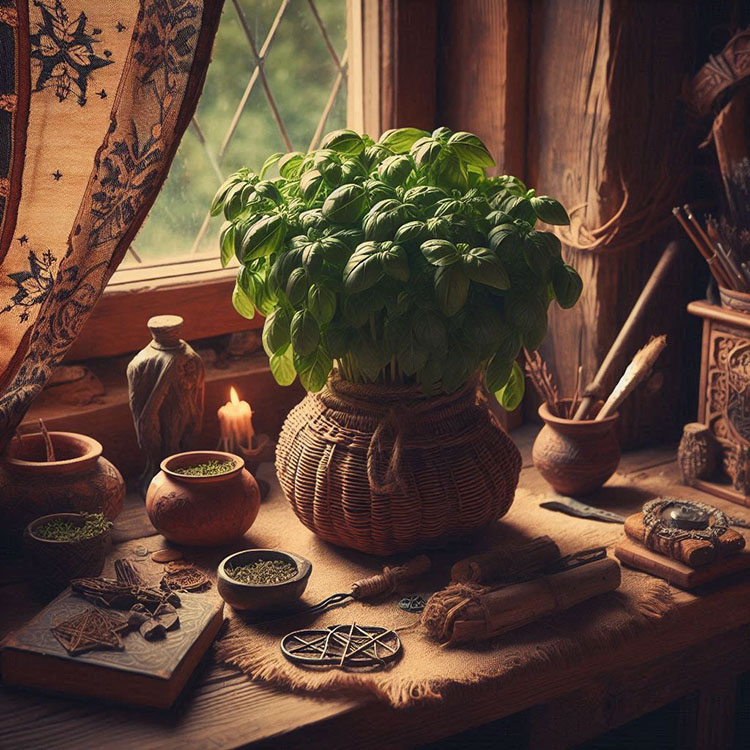
Basil, whose Latin name basilicum rather grandly means “royal herb,” has had an identity crisis for most of its existence. On one hand, it’s been linked to royalty annd churches – from the Greek words basileus (“king”) and basilica (“hall of the king”) . On the other, it somehow ended up associated with scorpions and the basilisk—a creature so dangerous it could kill you with a glance, a sneeze, or possibly just a strong opinion.
The ancient Greeks and Romans firmly believed basil could bring madness, misfortune, hatred, and fatigue—essentially the full Monday morning experience. In Crete, it was said that if you dared to snip basil from someone’s windowsill, you’d be cursed. (Whether this was a magical curse or just a neighbor with a temper and a shovel is unclear.)
In the Slavic world, basil had a more dramatic origin story. According to some legends, it first appeared at the very spot where Christ was crucified. Others say it sprang from His spilled blood. And then there’s the version where it sprouted from the grave of a youth named Vasyl (Basil).
A close relative of the common basil is Tulsi (Ocimum sanctum), also known as holy basil. In India, Tulsi is more than just a plant. It’s revered as sacred, dedicated to the god Vishnu, and generally treated with a great deal of respect. According to one legend, Tulsi was once a mortal woman who, in a fit of grief, hurled herself onto her husband’s funeral pyre—either out of love, custom, or a very strong sense of dramatic timing. Her soul was then transformed into the holy basil plant.
In another version of the tale, Tulsi isn’t just connected to the divine—she is the divine, being none other than an earthly incarnation of Lakshmi, Vishnu’s consort and the goddess of wealth, grace, and beauty. This makes harming the plant not only bad gardening but a cosmic faux pas. Vishnu, it is said, feels actual pain when Tulsi is mistreated and will pointedly ignore the prayers of anyone who thinks sacred herbs are for trampling.
However, if you place a Tulsi leaf on the body of the deceased, it’s believed to work like a divine passport—ensuring Vishnu spots the soul in the cosmic crowd and waves them into heaven.
Protection
In the old days, basil was treated less like a garnish and more like an amulet with excellent fragrance. It was widely revered as a protective herb, believed to offer universal safeguarding.
People used it to adorn themselves, animals, homes, household objects, and even food. It was often carried in secret—tucked into clothing or sewn into the hem of garments—as a hidden charm.
During weddings, basil was placed in ceremonial bread and mixed into the dough for ritual loaves, symbolizing blessing and protection.
Funerals, too, were rich in basil. Sprigs were laid around the deceased, placed at the head, in the hands, woven into wreaths for maidenly departures, or tucked gently beneath a woman’s head. Among the southern Slavs, those keeping vigil near the body would each hold a sprig of basil, a protective measure to prevent the recently vacated soul from getting ideas and taking someone else along for company.
In Bulgarian tradition, the phrase “May basil be brought to you” wasn’t a thoughtful culinary suggestion—it was a poetic, ominous curse. A veiled wish for death, elegantly scented.
Birth and New Life
In Slavic tradition, Basil also played an important role in childbirth rituals and the care of newborns, where things were equally magical, messy, and unpredictable.
For starters, a sprig of basil was placed beside women in labor to ease delivery.
After the baby arrived, basil was placed around the infant’s head to help it sleep. A bit of the plant was also tied into the corner of the swaddling cloth to ward off the evil eye, malevolent spirits, or just overly nosy neighbors.
The placenta, which had a whole afterlife of its own in Slavic folklore, was carefully buried like a small magical relic, and a sprig of basil was laid beneath it—as a blessing, or protection.
Then there was the First Haircut—an event that took place when the child turned one and had, presumably, accumulated just enough hair to make the ceremony worth the fuss. The clippings were scattered over basil, a gesture thought to bestow protection and luck.
Water Rituals
In many Slavic traditions, basil played a significant role in rituals connected to water. People often carried the plant with them when drawing water, adorning yokes, buckets, and jugs with its sprigs. It was customary to toss basil into wells and springs as a sort of leafy offering, either to bless the water or to bribe the local water spirits into not being awkward. And most impressively, basil branches were often used as ritual sprinklers—dipped in water or wine, waved about with purpose, and used to splash people at weddings, christenings, funerals, and seasonal ceremonies.
When it came to summoning rain—always a delicate art involving a great deal of stomping, singing, and optimism—basil once again took center stage. On St. John’s Day, for example, holy water was sprinkled across the fields using basil branches, in hopes that this would inspire the heavens to respond with rain, fertility and abundance.
Basil-infused water was believed to possess all sorts of magical properties and was used to ritually wash newlyweds, new mothers, newborns, the deceased, and even plowmen—at both the start and the end of the sowing season.

Love Magic
According to Slavic folk belief, basil could ignite romance, preserve marital devotion, and, if tucked into the right hemline, nudge fate in the direction of a promising suitor. For many centuries, girls would secretly sew it into the hems of their dresses, which was not especially comfortable but—according to tradition—more effective than just waiting around and hoping the boy in question could take a hint.
The symbolism of basil is vividly portrayed in folk songs, where offering a sprig to a boy expresses a girl’s affection, and tending a basil plant reflects her longing as she awaits her beloved. A trampled basil plant often symbolized lost virginity (which says quite a lot about both the symbolic weight of herbs and the state of village gossip). In tales of unrequited love, the girl herself would uproot the basil—folklore’s equivalent of marking the end of hope or desire.
In Italy, basil was not just romantic—it was positively smouldering. In traditional courtship, an unmarried woman might tuck a sprig into her undergarments—strategically placed near the more… persuasive regions of her anatomy—while a married woman, having presumably completed the basil-related business of attraction, wore it in her hair, safely above the neck and out of metaphorical reach.
When a man fancied a woman, he would present himself with a sprig of basil, placing it carefully on her windowsill—a respectful gesture of affection. Handing it to her directly would be far too forward. After all, one doesn’t just thrust basil at people. There are rules.
However, in some regions of Italy, gifting a pot of basil was simply considered a quiet emblem of love, and both men and women embraced this leafy language of affection. Italians, after all, have long been masters of romance — and seasoning.
And then there was Romania, where people believed that if a young woman could get a man to accept a sprig of basil from her hand, he’d fall hopelessly, helplessly, head-over-heels in love with her — like it or not. In neighboring Moldavia, the effect was even more dramatic: accepting basil from a woman didn’t just guarantee infatuation — it placed the poor man entirely under her control.
Healing Magic
In the grand tradition of magical healing basil was renowned for one very important thing: it could keep the bad stuff away. During plague outbreaks, that seemed to occur with alarming frequency, Serbian households, for example, would keep basil on their tables, use it to sprinkle over impure areas, or burn it as incense to purify the air. It was also applied directly to aching spots to alleviate pain.
According to Slavic tradition, the most powerful basil, of course, was the type that grew through the skull of a snake. Because, naturally, if a plant could sprout through a skull it had to be good for something important—like curing epilepsy, which it was said to do. Often, healers would hold a sprig of basil while chanting healing incantations,.
Basil that had been used in a ritual—say, in a wedding wreath or even better, blessed by the local priest—was thought to have a special, extra-potent quality.
- Gender: Masculine
- Sign/Planet: Leo / Mars
- Element: Fire
- Harvesting Time: Sun in Pisces or Moon in Cancer
- Symbolism: Anger that can turn into lust, love.
- Powers: Love, lust, protection, abundance.
Tags:
Leave a Reply